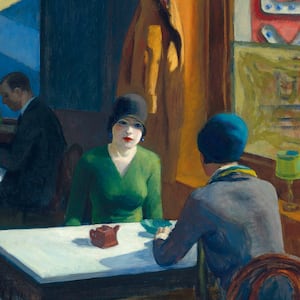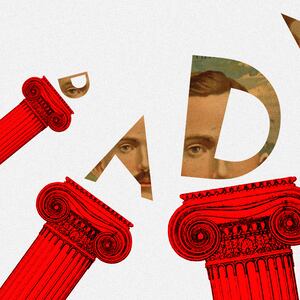TOLEDO, Spain–Roberto Polo has been reborn, after a fashion.
The suave 67-year-old art collector, once infamous and imprisoned, can now be found most days directing builders and architects in this hilltop town that served as the capital of the Spanish Empire in its glory days, half a millennium ago.
The workers are scurrying to convert the 13th century Convent of Santa Fe into a state museum of modern and contemporary art that will bear Polo’s name. It is due to open Wednesday, and if it succeeds it could bring a new wave of visitors to Toledo, which already is a recognized center of culture.
Polo says his collection, which includes over 7,000 paintings, sculptures, conceptual art and photos from the late 19th century to the present, could rewrite our understanding of the influential modernist movement.
It could also rewrite our understanding of him.
Polo had a spectacular fall from grace over three decades ago, spending four years in prison awaiting trial on charges of investor fraud. “I went through horrible things,” says Polo. “I fell deep. I have been through hell. But I survived. And here I am, doing what I love. Which is art.”
Even by today’s standards of overnight infamy, Polo’s tale is extraordinary. Nicknamed the Cuban Gatsby, the handsome Havana-born impresario burst onto the Manhattan art scene in the 1970s, organizing spectacular shows, setting up an art investment fund, and building one of the world’s largest private jewel collections. His flamboyance made him a fixture in the jet set of the time, as he hung out with the likes of Andy Warhol, Grace Jones and Karl Lagerfeld. Every week he would take Concorde flights to Paris, often visiting Milan, Monaco and Geneva.
Both art and business ran in his blood. His great-grandfather was the celebrated Spanish composer José María Castro, also known as Chané. His father was a Cuban engineer who built bridges, oil refineries and sugar mills, but fled when Fidel Castro seized power on the island.
Polo’s talent was his ability to buy counter to prevailing fashions: he would find undervalued art and resell when it came back in style. “If I can buy for $1,000, and sell for $350,000, it is because I can recognize artistic value,” he says.
He cultivated an image as an elegant aesthete, an astute forecaster with exquisite taste, always ahead of the art curve. He was passionate about art, and he let people know it. “With art, you have to live with it,” he says. “You have to sleep with it. You have to fuck with it.”
Polo’s grandiose lifestyle helped forge a reputation as an enigmatic man in a hurry. He was just 23 when he commissioned pieces by Warhol, David Hockney, Yves Saint Laurent and Richard Avedon for his influential “Fashion as Fantasy” exhibition. He was photographed by Bruce Weber for GQ magazine, which named him one of the best-dressed men in New York. He threw opulent charity balls.

He bought a five-story East Side townhouse and decorated it with Renoirs and Monets and Rodins. His Paris apartment overlooking the Seine had Matisses, Bonnards and Fragonards on its walls. He bought and sold jewels like the Ashoka Diamond, the Rockefeller Sapphire and the Dudley Pearl. He donated the crown of the Empress Eugénie, wife of Napoleon III, to the Louvre museum. France made him a Commandeur de l’Ordre des Arts et des Lettres.
But that all came crashing down in 1988 with what Polo describes as his “judicial affair.”
As his spending became more and more extravagant—he lost millions on a disastrous clothing and perfume venture—many of his investors began asking for their money back. Papers lodged in court described his operation as a $130 million swindle, claiming he stole from the same clients he had hoped to impress.
An international arrest warrant was issued. His former office manager, Ramona Colón, described in a sworn deposition how she was asked to hide the alleged fraud. “He also instructed me to erase all the time-deposit computer records,” she said. “He told me if they could not be erased, he would throw the computers into the river.”
Polo fled, and for five weeks was a fugitive from justice. He eventually was arrested in Viareggio on the Italian Riviera and thrown into a 14th century prison in the town of Lucca where he spent three months in solitary confinement. Polo says he was stripped naked, beaten by guards, and forced to sleep on a concrete floor. He says he had to protect his genitals with his hands from the cat-sized rats that roamed the prison.
When he was moved to a jail in Pisa, Polo tried to kill himself by drinking bleach. “I couldn’t go on. I wanted to die,” he says. When he became anorexic and his weight fell to 40 kilos (88 pounds), he was sent to a mental institution in Florence where he was kept in a straitjacket for five days.

Roberto Polo and his daughter in Venice, 1986.
Courtesy Roberto PoloBy then, a New York District Court issued a default judgment, ruling that Polo owed 13 of his clients more than $120 million. His homes in New York and Paris were raided, his paintings seized, and his assets sold to pay his creditors. Crime chronicler Dominick Dunne penned an excoriating profile in Vanity Fair. “An outsider with his nose pressed to the window, Roberto Polo wanted it all and he wanted it quick,” he wrote.
After his release in 1989, Polo jumped bail and fled to Miami. But he was arrested again in 1993 and extradited to Switzerland where he spent a further two years in a Geneva jail awaiting trial. He eventually was sentenced to the time served, and released on the last day of his 1995 trial.
Polo denied the charges then, and still vehemently protests his innocence. He says he was convicted without a trial, and double-crossed by a disgruntled employee and wealthy Mexican clients in “an elaborate and carefully premeditated scheme.”
“They never gave any evidence to show I had taken the money,” he says.
Nonetheless, the ordeal cost him his fortune, which he says was over $300 million at the time. “I didn’t have money to take the metro,” he says. “All I could do was rebuild myself.”
He collected again, starting with late 19th and early 20th century design in Paris, where he opened Galerie Historismus. In 2012, he moved to Brussels and opened the Roberto Polo Gallery to sell Belgian contemporary art. His 2016 exhibition, “Painting After Postmodernism,” boasted Belgium’s Queen Mathilde as patron and veteran art historian and critic Barbara Rose as curator. Slowly, he began restoring his reputation, and his ambition.
Polo’s latest project is certainly audacious. Formally named the “Roberto Polo Collection. Centre for Modern and Contemporary Art of Castilla-La Mancha”(the middle period is intentional), it is set to be Spain’s second biggest museum of contemporary and modern art after the Museo Reina Sofia in Madrid.

The museum will have two homes: one in Toledo and the other in Cuenca, some 180 km away. The Cuenca site will be a former historical public records building in a 10th century castle that was once the headquarters of the Spanish Inquisition–but will only open in 2023 after refurbishments. The entire project is funded by the Castilla-La Mancha region, so it is officially a state museum. The works will exhibited on a 15-year renewable loan, but Polo says he may well donate the entire collection to Spain.
What will be on show?
Polo reels off a long list of modernist artists like Wassily Kandinsky, Max Ernst, László Moholy-Nagy, Kurt Schwitters, Oskar Schlemmer, Pierre-Louis Flouquet, Jacques-Henri Lartigue and Léon Spilliaert. The collection will also feature 19th century artists like Eugène Delacroix and Honoré Daumier, as well as more recent names including Ed Moses, Melissa Kretschmer and Jan Vanriet. The first temporary exhibition is by Belgium’s Werner Mannaers.
The opening session has 445 works, which Polo says are valued for insurance purposes at nearly €400 million. Emiliano Garcia-Page, the president of the Castilla-La Mancha region, says it is Spain’s most important cultural operation since the national government bought the celebrated Thyssen-Bornemisza collection in 1993.
But Polo says the main aim of the museum is to show the true story of modernism. “I think this will rewrite art history in the period from 1890 to 1932, particularly for the artists who had fallen into oblivion, and show they did it before artists who are very well known,” he says.
For example, he names Belgian Paul Joostens as the first true Dada artist: his Dada collages date from 1916, three years before Germany’s Kurt Schwitters, who is often credited as the movement’s originator. He is particularly keen on Art Nouveau pioneer Henri Van de Velde, whom he describes as Western art’s first abstractionist. “He was a painter, architect, furniture designer, the father of modern design theory, and—importantly—the founder of the art school in Weimar that became the Bauhaus,” Polo says.
This trailblazing quality is what Polo says will distinguish the museum. “Most museums in recent years have been about telling people what they already know. We know the artists we are going to see, and we even know the works we are going to see. It is singing the same song. Our museum will instruct people. That is the role of the museum: to shed new light,” he says.
This discourse on art as invention has not changed over the decades. Polo still talks eloquently and effusively about who he sees as the real innovators. “It is very important to be modern in your own time,” he says. He also seems to be speaking about himself.
As he counts down the days until the museum opens, Polo has become reflective about his own story. He does not shy away from his past. “It’s part of my life. I’m proud of it,” he says. But he sees his legacy in different terms, as a man who told the world about art and beauty. “When I think of where I am now, it makes me cry. I survived, and I did it for art. What could be better?”




